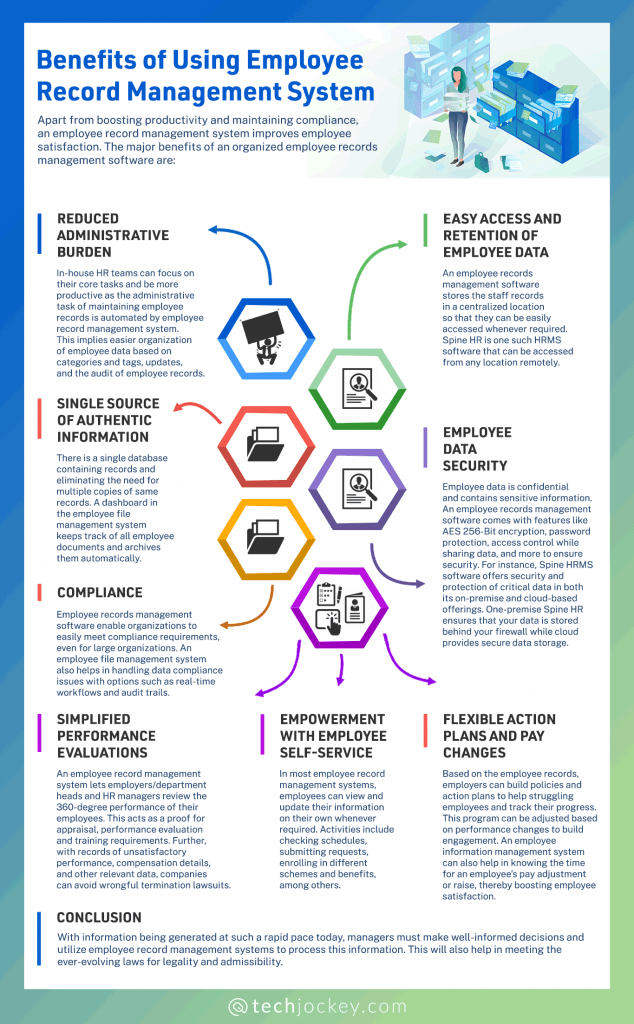How Does Employee Record Management System Help Manage Staff Records

Maintaining accurate and up-to-date employee records is necessary for any organization. It helps the employers have better control over the information of their current and former employees and get all the valuable data for legal and audit purposes.
All central, state, local government agencies as well as public and private institutions use an employee file management system to store employee information for effectively carrying out day-to-day activities.
In this article, we discuss the best approach to managing staff records for any business and how an employee information management system is beneficial in the long run.
How to Maintain Employee Records Efficiently?
The traditional way of maintaining employee records is to use a manual bookkeeping system. In this approach, you create an employee journal with page-wise records of each employee in detail.
This paper-based employee information management system includes all the personal and professional information collected during the hiring process, such as address, contact number, department in the company, joining date, leave, and payroll activity.
However, this form of employee record keeping system is complex to manage as HR professionals must constantly update the documentation during each employee’s tenure.
Suggested Read: 10 Best Free Time Tracking Software For Employees
Since these sheets can get lengthy and cumbersome, most businesses prefer to use computerized systems nowadays. Handling data compliance, audit, and legal issues with a manual employee file management system is also challenging.
In the digital approach, the data is stored in the form of electronic records for easy access, updating, sharing. There is one database of records at a single location that is easy to manage and retain.
The electronic record keeping system that automates the organization and maintains employee records is called the employee record management system. HR professionals can create their organizational policies in the employee file management system.
What Is Employee Record Management System?

Employee record management system is an electronic filing application that assists HR professionals in capturing and storing employee records and tracking the data to run an organization smoothly.
These records include a personal profile, attendance and leave records, salary information, medical history, overall performance, and so on. An employee record keeping system checks every employee’s performance and helps understand their strengths and training requirements.
It ensures that your employees can give their best to achieve the overall targets and goals of an organization. Employee record-keeping software plays a significant role in improves the productivity and efficiency of the workplace.
Suggested Read: 21 Best Paid, Free and Open Source Employee Monitoring Software India
Benefits of Using Employee Record Management System

Apart from boosting productivity and maintaining compliance, an employee record management system improves employee satisfaction. The major benefits of organized employee records management software are:
- Reduced Administrative Burden
In-house HR teams can focus on their core tasks and be more productive as the administrative task of maintaining employee records is automated by an employee record management system. This implies easier organization of employee data based on categories and tags, updates, and the audit of employee records.
- Easy Access and Retention of Employee Data
An employee records management software stores the staff records in a centralized location so that they can be easily accessed whenever required. Spine HR is one such HRMS software that can be accessed from any location remotely.
This is true throughout the lifecycle- from the information collection until the records become inactive and are only retained for fiscal, legal, or other purposes. These systems have advanced search capabilities which make it easy to retrieve records upon request for analysis or audit at any time.
- Single Source of Authentic Information
There is a single database containing records and eliminating the need for multiple copies of the same records. A dashboard in the employee file management system keeps track of all employee documents and archives them automatically.
Every change made by an admin, manager, or employee is reflected across HR, payroll, benefits, and other modules. The system helps prevent errors during updates and saves time.
The employee record keeping system can easily integrate with other existing systems of an organization and streamline all business processes. Spine HR software, for example, prevents duplicate HR entries, multiple Excel reports, and issues in data migration.
- Employee Data Security
Employee data is confidential and contains sensitive information. An employee records management software comes with features like AES 256-Bit encryption, password protection, access control while sharing data, and more to ensure security.
For instance, Spine HRMS software offers security and protection of critical data in both its on-premise and cloud-based offerings. One-premise Spine HR ensures that your data is stored behind your firewall while the cloud provides secure data storage.
You can also check Spine HRMS Reviews by customers before making any purchase!
- Compliance
Employee records management software enables organizations to meet compliance requirements, even for large organizations, easily. An employee file management system also helps in handling data compliance issues with options such as real-time workflows and audit trails.
Spine HRMS is a popular choice for organizations who want to reduce the burden of manually keeping up to date with their country’s latest rules and regulations.
- Simplified Performance Evaluations
An employee record management system lets employers/department heads and HR managers review the 360-degree performance feedback of their employees. This acts as a proof for appraisal, performance evaluation, and training requirements.
Further, companies can avoid wrongful termination lawsuits with records of unsatisfactory performance, compensation details, and other relevant data.
- Empowerment with Employee Self-Service
In most employee record management systems, employees can view and update their information on their own whenever required. Activities include checking schedules, submitting requests, enrolling in different schemes and benefits, among others.
By using an employee information management system that offers a self-service portal, the work of HR departments also decreases.
Spine HR enables managers, HR staff, and employees to increase company transparency, thereby lowering attrition rates.
- Flexible Action Plans and Pay Change
Employers can build policies and action plans to help struggling employees track their progress based on the employee records. This program can be adjusted based on performance changes to build engagement.
An employee information management system can also help in knowing the time for an employee’s pay adjustment or raise, thereby boosting employee satisfaction.
Conclusion
With information being generated rapidly today, managers must make well-informed decisions and utilize employee record management systems to process this information. This will also help in meeting the ever-evolving laws for legality and admissibility.
Suggested Read: 14 Best Employee Management System for Small Business in India
FAQs
How long to keep payroll records?
Payroll records for an employee must be kept for a minimum of three years after the last entry into the system.
How long to keep employee files?
Different states and countries have laws governing the period for which an employer must keep employee files. In India, most files must be preserved for at least a period of 3 to 10 years, depending on the document.
What are the payroll record keeping requirements?
According to labour and employment laws, payroll record keeping is statutory compliance. The data includes employee bonus, insurance, PF, and so on.
If the records are not maintained for the requisite period, there are penal provisions under different acts.
Related Categories: Employee Scheduling Software | Employee Desktop Monitoring Software | Employee Recognition Software
Ayushee is currently pursuing MBA Business Analytics from SCMHRD, Pune with a strong background in Electronics and Communication Engineering from IGDTUW. She has 2 plus years of full-time work experience as an SEO content writer and a Technology Journalist with a keen interest the amalgamation of business and... Read more




























